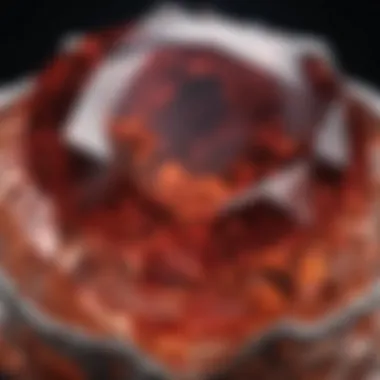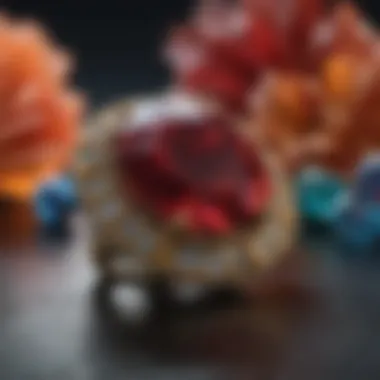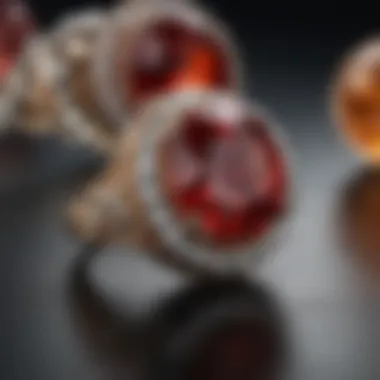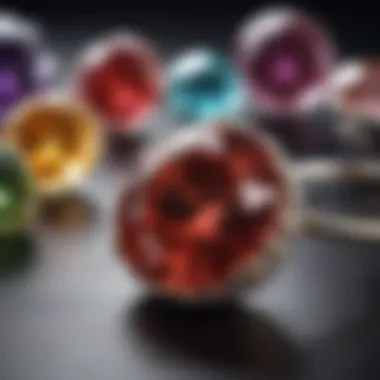The January 24 Birthstone: Exploration and Significance


Intro
January is often synonymous with fresh beginnings, and those born on January 24 carry a unique connection to their birthstone. The birthstone linked to this date, specifically, is garnet. Understanding this gemstone's qualities and significance goes beyond mere aesthetics. The garnet has a rich historical narrative intertwined with cultural meanings, healing properties, and even market dynamics. This article aims to dissect these facets, helping both gem enthusiasts and collectors appreciate the garnet’s allure.
Gemstone Overview
Definition and Characteristics
At its core, garnet is a group of silicate minerals that manifest in various colors. The most recognized variant, the deep red garnet, often symbolizes love and vitality. However, garnets also occur in greens, yellows, and even colorless forms. Their hardness ranks at 6.5 to 7.5 on the Mohs scale, which gives them reasonable durability for jewelry applications.
Garnets exhibit a unique crystal structure known as a dodecahedron, lending them intriguing visual effects. They can have a transparency that varies from opaque to brilliant, making them intriguing to collectors and jewelers alike.
Classification of Gemstones
Garnet belongs to the broader category of gemstones that can be classified into two major groups: precious and semi-precious stones. Traditionally, precious stones include diamonds, rubies, sapphires, and emeralds. In contrast, garnets are considered semi-precious, although their aesthetic appeal remains on par with the former category.
Within the garnet family, several varieties exist, categorized by their chemical composition. Key types include:
- Almandine: Deep red to violet hues, common in jewelry.
- Pyrope: Often bright red, resembling ruby.
- Spessartine: Orange to reddish hues, increasingly sought after.
- Tsavorite: A vibrant green garnet appreciated for its rarity.
This classification not only demonstrates the diversity within garnets but also their market presence in both luxury and everyday fittings.
Historical Significance
Ancient Uses and Cultural Importance
Garnets have a longstanding history dating back to ancient civilizations. The Egyptians used garnets in decorative jewelry and burial tombs, believing they offered protection in the afterlife. Historians note that garnets were often used as talismans. The Romans also prized garnets, crafting them into intaglio seals and intricate pieces that adorned their attire.
Myths and Legends Surrounding Gemstones
Various myths link garnets to attributes of power, strength, and protection. In medieval times, they were considered to illuminate the night, thus providing guidance and safety during dark travels. Ancient cultures believed garnets possessed healing properties, aiding in issues related to blood, heart, and mental clarity.
"In connection with love, garnets symbolize passion and commitment, making them popular choices for engagement rings and gifts."
This significance extends beyond the past, influencing contemporary jewelry choices and investment interests.
Finale
Garnets, as the birthstone for those born on January 24, offer a compelling blend of historical richness, intrinsic beauty, and ongoing market relevance. Whether as a personal adornment or an investment opportunity, understanding garnets empowers individuals to appreciate their worth fully.
Prelude to January Birthstones
January birthstones hold a unique place in both personal and cultural realms. Their charm goes beyond aesthetic beauty; they represent various qualities and beliefs that resonate with individuals born in this month. Understanding these gemstones is essential for appreciating their historical significance and relevance in contemporary society.
Overview of Birthstones
Birthstones have long been associated with significance tied to one's birth month. Each month features a particular gemstone, which is often thought to bring good fortune or embody certain traits. For January, the primary birthstone is garnet. Historically, garnet symbolizes protection and is believed to promote vitality. However, other stones, such as rose quartz and emerald, may also be associated with this month, depending on cultural beliefs and practices. The exploration of these stones reveals the diverse meanings they carry through epochs.
Cultural Significance of January Birthstones
The relevance of January birthstones extends deeply into various cultures. Garnet, for example, has been cherished since ancient times, often used in talismans and jewelry. In many cultures, it symbolizes love and fidelity, marking it as an ideal gift for anniversaries or romantic occasions. In other traditions, it is seen as a stone of purity and truth.
Each culture has its interpretation of the January birthstone's properties. Ancient Romans, for instance, valued garnets for their supposed ability to keep the wearer safe during travel. Meanwhile, in the Middle Ages, it was believed that garnets could illuminate the dark and banish negative thoughts. This long-standing appreciation underscores the gemstone’s potential influence on human experiences and emotions.
Thus, the examination of January birthstones transcends mere aesthetics, offering insight into how these gems weave through personal significance and cultural heritage. Understanding their multifaceted meanings adds depth to both the appreciation of the stones themselves and the stories they tell.
The January Birthstone
The importance of the January 24 birthstone extends beyond mere aesthetics. This gem embodies historical significance, geological wonders, and cultural appeals. As January harbors various gemstones, the unique properties of the stones can tell a lot about the person born this month. Understanding these aspects sheds light on the role of the January 24 stones in jewelry making and people’s lives.
Identification of the Gem


Types of January Birthstones
January boasts several birthstones, each known for specific characteristics. Two primary types are garnet and rose quartz. Garnet, the most recognized, is valued for its deep red hues and excellent durability. It is often regarded as a protective stone. The mystical qualities attributed to garnet can make it an exciting choice for those interested in metaphysics. Conversely, rose quartz, with its soothing pink shade, symbolizes love and compassion, appealing mostly to sentimental individuals.
The inclusion of diverse types of January birthstones allows for personal expression in jewelry.
- Garnet: Known for vibrant colors, it is often used in intricate designs.
- Rose Quartz: Preferred for its gentle appearance, it attracts a different clientele.
This variety enriches the marketplace as customers can choose based on their personality or the specific hue they favor.
Primary Gemstone for January
For those born on January 24 specifically, garnet is the primary gemstone. Its robust nature and striking colors make it a popular choice for many types of jewelry. Garnet is regarded not only for its beauty but also for the emotional protection it is believed to offer.
Key characteristics of garnet include:
- Vibrancy: Its ability to catch light and emit a rich glow.
- Durability: Rated around 7.5 on the Mohs scale, making it suitable for daily wear.
The unique features of garnet, such as its color saturation and versatility, provide numerous advantages for both designers and wearers. However, because garnets can be relatively common stones, their value can sometimes be less than that of rarer gems.
Geological Background
Formation and Origin
Garnet forms under specific geological conditions, typically in metamorphic rocks. Its crystalline structure results from high pressure and temperature, contributing significantly to its durability. Understanding the formation process offers insights into its beauty and resilience. This aspect is beneficial for collectors who wish to know their gem's history.
- Unique Features: There are multiple garnet varieties, such as almandine and pyrope, each with distinct characteristics.
- Advantages: The beauty and strength of garnet make it a favorite among jewelers and collectors alike.
However, this geological background also indicates that high-quality garnets are sometimes found deep within the Earth, which may affect their availability.
Global Sources of January Stones
The sources of garnet and other January stones are spread across numerous countries. Notable origins include:
- USA: Particularly in Arizona and New Mexico for its rich deposits.
- India: Known for producing high-quality garnets, it caters to both local and global markets.
These global sources contribute to the stone’s accessibility and popularity. The variety of origins also ensures that buyers have choices regarding quality and price, making it a wise selection.
Understanding the origins of garnet can enhance its appreciation, connecting buyers to its natural beauty and geological journey.
Physical Properties of the January Birthstone
The physical properties of the January birthstone play a fundamental role in determining its aesthetic appeal and practical applications. Understanding these characteristics is essential not only for enthusiasts and collectors but also for those looking to purchase high-quality gemstones. Specifically, the aspects of color, clarity, hardness, and overall durability contribute to the stone's market value and desirability. Notably, these factors can significantly influence how the stone is perceived in jewelry and are critical for long-term maintenance.
Color and Clarity
The color of a gemstone is one of its most defining qualities. For January birthstones, such as garnet, hues can range from deep red to vibrant green, depending on the specific variety. The richness of color can affect both the visual appeal and the valuation of the stone. Clear gemstones, without significant inclusions, are generally more sought after. Clarity refers to the absence of internal or external flaws. Higher clarity usually indicates a higher quality stone, making it more desirable in the market.
Factors affecting color and clarity include:
- Impurities: Elements within the stone can alter its color. For example, the presence of iron often gives garnet its popular red tones.
- Cut Quality: A well-cut gemstone can enhance its color and clarity. Good cutting practices maximize light reflection and minimize perceived flaws.
- Lighting Conditions: The surrounding light can change the appearance of color in gemstones. Natural light often offers a true representation, while artificial light can create misleading impressions.
Hardness and Durability
The hardness of a gemstone measures its resistance to scratching. This property is vital for everyday wear, especially in jewelry. The Mohs scale, which ranks minerals based on their hardness, places garnet at between 6.5 to 7.5. This indicates it is comparatively sturdy, though care should still be taken to avoid impact or scratches from harder materials.
Durability also encompasses factors like toughness, which is the stone's ability to withstand impacts, and stability, referring to how a gemstone reacts to environmental conditions such as light and heat. For instance:
- Toughness: Garnet is reasonably tough, making it suitable for rings or bracelets that endure daily wear. However, it might still be prudent to reserve softer stones for less frequently worn pieces.
- Stability: Exposure to prolonged sunlight can fade some garnet varieties. To preserve their beauty, it is advisable to store them away from direct sunlight when not in use.
"Understanding the physical properties of the January birthstone is essential for collectors and jewelry designers alike, providing insights into both beauty and durability."
Metaphysical Associations


Metaphysical associations related to gemstones play a pivotal role in how individuals perceive and utilize these stones. For the January 24 birthstone, these associations often include symbolic meanings and healing properties that date back centuries. Engaging with these aspects offers insight into the values placed on such stones, both spiritually and emotionally.
Symbolic Meaning
The symbolic meaning of the January 24 birthstone varies across cultures and traditions. Common interpretations include strength, resilience, and a fresh start. This gem is often seen as a representation of inner peace and stability. Those born on January 24 might resonate with these attributes, viewing their birthstone as a source of personal empowerment.
Additionally, it is commonly believed that this stone can protect the wearer from negative energies. Many people wear this gem during challenging times, relying on its reputed ability to foster confidence and courage. The birthstone is also associated with loyalty and sincerity, reinforcing the importance of these traits in relationships. Understanding the symbolic meaning can enhance the personal value of the birthstone, making it not just an accessory but a significant part of one’s identity.
Healing Properties
The healing properties attributed to the January 24 birthstone are widely recognized in holistic practices. It is thought to have a calming effect on the mind and body. Supporters argue that wearing this gemstone may alleviate anxiety, promoting emotional balance. Many enthusiasts claim it helps recharge the spirit and fosters a sense of tranquility among its users.
Another dimension of its healing properties includes physical health benefits. Some proponents believe that this gem can improve circulation and enhance overall vitality. It is suggested that the energies of the stone support the immune system and may aid in detoxification.
In summary, the metaphysical associations of the January 24 birthstone encompass a rich tapestry of meanings and healing capabilities. These aspects not only elevate the gemstone’s status but also offer individuals a deeper connection to their birthstone and its potential influence on their lives.
Care and Maintenance of the Birthstone
Proper care and maintenance of the January 24 birthstone is essential for preserving its beauty and integrity over the years. Understanding the right protocols not only enhances the stone’s aesthetic appeal but also ensures its longevity. Regular maintenance can help prevent damage and keep the gem in pristine condition. In this section, we will discuss critical cleaning techniques as well as the differences between commercial products and home remedies to approach cleaning effectively.
Cleaning Guidelines
Cleaning a gemstone is an integral part of its maintenance. Each type of January birthstone—be it garnet, rose quartz, or other variations—may require specific care instructions. Here are some general guidelines:
- Use Mild Soaps: Always opt for a mild soap and warm water solution. Harsh chemicals can damage the stone.
- Soft Cloths: Utilize a soft, lint-free cloth for drying. Avoid rough textile which can scratch the surface.
- Avoid Ultrasonic Cleaners: These devices can vibrate too harshly for softer stones, leading to potential cracks or chips.
- Regular Inspections: Check for loose stones in settings and any discoloration or scratches that may require professional attention.
Following these basic cleaning guidelines can extend the life of your gemstone, ensuring that it retains its charm and brilliance over time.
Commercial vs. Home Remedies
When it comes to cleaning gemstones, the choice between commercial products and home remedies often arises. Both approaches have their merits:
- Commercial Products:
- Home Remedies:
- These are specifically formulated for gemstones, offering convenience and safety when used as directed. Brands like "Windex" or "GemAqua" promise effective results tailored for specific gem types.
- Certain professional jewelers offer cleaning solutions tailored to different kinds of stones, providing immediate actions for dirt and stains.
- Simple solutions often suffice. For example, a mixture of vinegar and baking soda creates a non-abrasive cleaning paste that is effective for many stones.
- Using a bit of olive oil can enhance the gemstone’s shine. However, it should not be frequently used as it may leave residue.
Ultimately, the decision hinges on the gem type and personal preference. It is wise to consider that while home remedies may seem effective, for exquisite or rare gemstones, investing in professional-grade products may be more beneficial in ensuring the gem's safety and quality.
"Maintaining the beauty of the January birthstone is a duty to its significance. Its luster reflects not just aesthetics but also the care it receives over the years."
The right approach in cleaning and maintaining your January 24 birthstone guarantees its lasting appeal, fostering an enduring connection to its inherent value and elegance.
Market Trends and Valuation
Understanding market trends and valuation for the January 24 birthstone is essential for enthusiasts, investors, and collectors. This section examines the dynamics of the gemstone marketplace, providing insight into current values and potential investment opportunities. Awareness of market trends aids in making informed decisions, whether one seeks to purchase jewelry, invest in gemstones, or simply appreciates their beauty.
Current Market Value
The market value of the January 24 birthstone can fluctuate based on various factors. These factors include demand, availability, and quality. As of recent years, the price of garnet, the primary birthstone for January, has shown notable variations.
Factors influencing these values include:
- Quality: The clarity, color, and cut affect pricing.
- Rarity: Some garnets are rarer than others, impacting their value significantly.
- Market Demand: Trends in fashion can readily shift prices; high demand can lead to increased valuations.
- Economic Conditions: Broader economic shifts can also impact the luxury market where gemstones are traded.
In general, the average price for high-quality garnets can range from $20 to $100 per carat. However, unique colors and exceptional pieces can command much higher prices.
Investment Potential
Investing in the January 24 birthstone presents intriguing possibilities. For a discerning buyer, garnets can serve both aesthetic and financial purposes. As noted, the gemstone market tends towards fluctuations, thus presenting risks but also potential for rewards. Here are some considerations for potential investors:


- Long-Term Value: While garnets may not yet be as famous as diamonds or sapphires, their value has the potential for appreciation.
- Diversification: Adding garnets to a gemstone collection can diversify one's investment portfolio. This strategy provides an opportunity to buy into lesser-known gemstones that may rise in popularity over time.
- Market Trends: Keeping an eye on fashion trends and jewelry design can indicate possible increases in garnet demand, which may affect value positively.
"Investing in gemstones, such as the January 24 birthstone, requires careful research and an understanding of market dynamics."
Ecological and Ethical Considerations
The ecological and ethical aspects of gemstone sourcing have gained significant attention in recent years. As awareness of environmental impacts and social issues become paramount, understanding these factors is essential for consumers and professionals alike. This section will explore two main areas of concern: sustainability in gem mining and ethical sourcing practices.
Sustainability in Gem Mining
Sustainability in gem mining emphasizes the need for responsible extraction methods that minimize environmental degradation. Traditional mining techniques often lead to destruction of habitats, soil erosion, and contamination of water resources.
Adopting sustainable practices can mitigate these negative effects. Here's a closer look at several approaches that can enhance sustainability in the gem mining industry:
- Rehabilitation Initiatives: After mining activities, restoring ecosystems is vital. Companies should implement rehabilitation strategies to restore the land to its original state or better.
- Use of Eco-Friendly Technologies: Modern mining operations are exploring advanced technologies. These tools can optimize resource extraction while reducing waste and pollution.
- Community Involvement: Engaging local communities in decision-making processes is crucial. Empowering these groups ensures that their voices are heard and that their rights and needs are respected during mining operations.
Fostering sustainability not only helps in preserving the environment but also enhances the long-term viability of gem mining as an industry.
Ethical Sourcing Practices
Ethical sourcing practices focus on ensuring that gemstones are mined and traded without exploitation. The gemstone industry has faced scandals related to human rights abuses and worker exploitation.
Here are some key elements of ethical sourcing practices:
- Transparency: Companies should be clear about their supply chains. This transparency builds trust with consumers and highlights a commitment to ethical standards.
- Fair Labor Practices: It is important for companies to support fair wages and safe working conditions in mining operations. This helps protect workers from exploitation.
- Certification Initiatives: Various organizations have developed certification programs aimed at verifying ethical practices. Engaging with these certifications can assure consumers of a gemstone's ethical origins.
In summary, understanding ecological and ethical considerations is integral to appreciating the January 24 birthstone. Prioritizing sustainability and ethical sourcing not only safeguards the planet but also supports social responsibility.
"The true value of a gemstone extends beyond its aesthetic appeal; it reflects the integrity of its origins."
By making informed choices about sourcing and supporting responsible practices, enthusiasts can contribute positively to the industry, enhancing both the joy and righteousness of their gemstone purchases.
Popular Jewelry Styles Featuring the January Birthstone
The January birthstone represents various unique gems that adorn various types of jewelry. Their aesthetic appeal is not the only reason they are desired. The qualities of these stones make them suitable for different jewelry styles, each holding its significance. Understanding these jewelry styles can inspire individuals seeking pieces for personal collection or gift-giving purposes.
Bracelets and Necklaces
Bracelets and necklaces are two of the most popular jewelry forms featuring January birthstones. These pieces enhance personal style while also providing a means to express individuality. Often, January birthstones such as garnets and other associated gems are set in both elegant and casual designs.
- Design Versatility: The shapes and sizes of these gems can cater to diverse tastes. From minimalist designs to intricate patterns, there is a piece for everyone. Gemstones can be set in silver, gold, or even mixed metals, allowing a higher appeal.
- Symbolism of Connection: Wearing a bracelet or necklace with a January birthstone can symbolize connection and warmth. In many cultures, these accessories are seen as talismans that provide love and protection.
- Layering Trends: Currently, layering necklaces and bracelets are very trendy. Combining different styles with January birthstones creates a personalized look. This flexibility allows wearers to curate their collection based on occasions or moods.
Earrings and Rings
Earrings and rings can also showcase the charm of January birthstones effectively. These items serve distinct purposes while retaining common thematic elements, which enhances their allure.
- Earrings: Earrings serve as focal points in any jewelry collection. From stud earrings adorned with garnet to dangling designs featuring various January birthstones, they provide options for casual and formal wear alike. Many individuals opt for colored stones to create a vibrant visual element, adding depth to their overall outfit.
- Rings: Rings are significant in various cultures, often seen as symbols of commitment or ownership. Many enjoy wearing a simple band featuring a January birthstone. Others prefer statement rings where larger stones are highlighted. The popularity extends beyond aesthetics as many view rings as personal identifiers, each ring telling a unique story.
In summary, the versatility and appeal of jewelry featuring January birthstones are noteworthy. Whether in bracelets, necklaces, earrings, or rings, these pieces not only serve to enhance beauty but also to express deep meanings.
Jewelry featuring January birthstones typically combines both aesthetic appeal and rich cultural significance.
End
The conclusions drawn in this article carry significant weight for anyone interested in January 24 birthstone. They encapsulate critical insights regarding the gemstone's unique properties, cultural significance, and market dynamics. By summarizing the essential aspects discussed, readers can grasp how the birthstone has remained relevant across time, both as a personal adornment and an investment opportunity.
Recap of Key Insights
The January 24 birthstone is more than a mere ornament. It boasts a rich historical background and possesses unique characteristics that appeal to both collectors and enthusiasts alike. Key insights include:
- Diverse Geological Origins: Understanding the geographical roots and formation processes of this gemstone provides valuable context.
- Physical Attributes: Features such as color, clarity, and hardness influence its desirability for jewelry.
- Metaphysical Properties: Many people are drawn to the believed healing properties of the stone.
- Market Trends: Current valuation and demand reflect the stone's popularity in contemporary jewelry designs.
Overall, the intersections of these factors give the January 24 birthstone its importance in both personal and commercial realms.
The Birthstone's Role in Today’s Market
In today’s competitive gemstone market, the January 24 birthstone showcases itself as a viable option for both aesthetic pleasure and financial investment. Market research indicates a steady demand, fueled by increasing interest from younger consumers in personalized jewelry. The significance of this birthstone is evidenced by its integration into various jewelry styles, making it a versatile choice for numerous occasions. Moreover, fashion trends emphasize sustainable and ethically sourced gems, positioning this birthstone favorably in discerning consumer circles.
As trends evolve, the importance of education on the gemstone cannot be overstated. Understanding its qualities not only aids in informed purchasing decisions but ensures that today’s buyers appreciate the stone's deeper value beyond immediate aesthetic appeal. Thus, the role of the January 24 birthstone in the market today transcends mere adornment—reflecting a blend of culture, emotion, and economic consideration.







